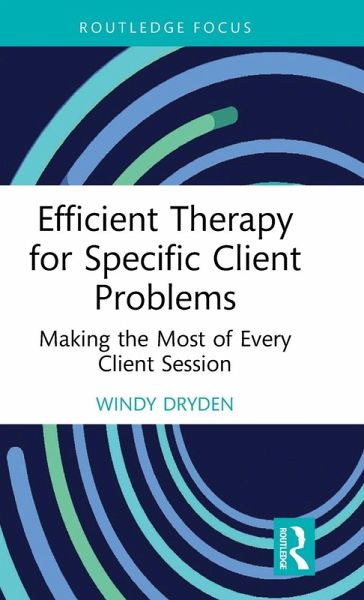- Gebundenes Buch
- Merkliste
- Auf die Merkliste
- Bewerten Bewerten
- Teilen
- Produkt teilen
- Produkterinnerung
- Produkterinnerung
Most clients seeking therapy want to be helped with specific emotional problems with which they are struggling, and yet many therapists are reluctant to offer problem-focused therapy.
Andere Kunden interessierten sich auch für
![Working Creatively with Obstacles to Client Change in Rational Emotive Behaviour Therapy Working Creatively with Obstacles to Client Change in Rational Emotive Behaviour Therapy]() Windy DrydenWorking Creatively with Obstacles to Client Change in Rational Emotive Behaviour Therapy194,99 €
Windy DrydenWorking Creatively with Obstacles to Client Change in Rational Emotive Behaviour Therapy194,99 €![Working with Client Experiences of Domestic Abuse Working with Client Experiences of Domestic Abuse]() Working with Client Experiences of Domestic Abuse194,99 €
Working with Client Experiences of Domestic Abuse194,99 €![Systemic Coaching Systemic Coaching]() Peter HawkinsSystemic Coaching187,99 €
Peter HawkinsSystemic Coaching187,99 €![Dealing with Emotional Problems Using Rational Emotive Behaviour Therapy (Rebt) Dealing with Emotional Problems Using Rational Emotive Behaviour Therapy (Rebt)]() Windy DrydenDealing with Emotional Problems Using Rational Emotive Behaviour Therapy (Rebt)187,99 €
Windy DrydenDealing with Emotional Problems Using Rational Emotive Behaviour Therapy (Rebt)187,99 €![Dealing with Emotional Problems Using Rational Emotive Behaviour Therapy (Rebt) Dealing with Emotional Problems Using Rational Emotive Behaviour Therapy (Rebt)]() Windy DrydenDealing with Emotional Problems Using Rational Emotive Behaviour Therapy (Rebt)187,99 €
Windy DrydenDealing with Emotional Problems Using Rational Emotive Behaviour Therapy (Rebt)187,99 €![Claimant or Client? Claimant or Client?]() Olive StevensonClaimant or Client?156,99 €
Olive StevensonClaimant or Client?156,99 €![Solution Focused Brief Therapy with Children and Young People who Stammer and their Parents Solution Focused Brief Therapy with Children and Young People who Stammer and their Parents]() Ali BerquezSolution Focused Brief Therapy with Children and Young People who Stammer and their Parents165,99 €
Ali BerquezSolution Focused Brief Therapy with Children and Young People who Stammer and their Parents165,99 €-
-
Most clients seeking therapy want to be helped with specific emotional problems with which they are struggling, and yet many therapists are reluctant to offer problem-focused therapy.
Hinweis: Dieser Artikel kann nur an eine deutsche Lieferadresse ausgeliefert werden.
Hinweis: Dieser Artikel kann nur an eine deutsche Lieferadresse ausgeliefert werden.
Produktdetails
- Produktdetails
- Verlag: Taylor & Francis Ltd
- Seitenzahl: 80
- Erscheinungstermin: 7. Mai 2025
- Englisch
- Abmessung: 216mm x 138mm
- ISBN-13: 9781032890210
- ISBN-10: 1032890215
- Artikelnr.: 72210824
- Herstellerkennzeichnung
- Libri GmbH
- Europaallee 1
- 36244 Bad Hersfeld
- gpsr@libri.de
- Verlag: Taylor & Francis Ltd
- Seitenzahl: 80
- Erscheinungstermin: 7. Mai 2025
- Englisch
- Abmessung: 216mm x 138mm
- ISBN-13: 9781032890210
- ISBN-10: 1032890215
- Artikelnr.: 72210824
- Herstellerkennzeichnung
- Libri GmbH
- Europaallee 1
- 36244 Bad Hersfeld
- gpsr@libri.de
Windy Dryden is in clinical and consultative practice and is an international authority on Single-Session Therapy. He is Emeritus Professor of Psychotherapeutic Studies at Goldsmiths, University of London. He has worked in psychotherapy for more than 45 years and is the author or editor of over 275 books.
Introduction 1. Find Out What the Person Wants from Therapy and Offer
Problem-Focused Help When Appropriate 2. Get Informed Consent 3. Adopt a
Client-Led Stance 4. Encourage Your Client to Prepare for the First and
Subsequent Therapy Sessions 5. Use the Working Alliance Concept as a
General Guide to Your Work with Your Client 6. Begin Therapy with Your
Client As Soon as Possible 7. Develop a Problem List with Your Client and
Set an Agenda for Each Session 8. Encourage Your Client to Get the 'Feel'
of Being in Therapy with You,if Necessary 9. Establish and Maintain
Meta-Therapy Communication with Your Client 10. Identify and Focus on Your
Client's Nominated Problem 11. Be Goal Directed with Your Client 12.
Problem Assessment: Be Specific with Your Client 13. Be Solution-Focused
with Your Client 14. Steps to Take Before Helping Your Client Find a
Solution 15. Help Your Client to Select the Solution that Works Best for
Them 16. Help Your Client Try Out the Solution in the Session 17. Help Your
Client Develop a Plan to Implement Their Chosen Solution 18. Deal with Your
Client's Obstacles to Change Before and When They Occur 19. Uncover and
Deal with Your Client's Doubts, Reservations and Objections to Therapy 20.
Invite Your Client to Summarise the Session and Specify Takeaways 21.
Invite Your Client to Generalise Their Learning to Other Relevant Aspects
of Their Life 22. End Each Therapy Session Well with Your Client 23.
Encourage Your Client to Schedule Sessions (or Not) As They See Fit 24.
Encourage Your Client to Engage in Post-Session Reflection 25. Review
Periodically Your Client's Views About Therapy Overall and Their Progress
26. End Therapy Well with Your Client References Appendix 1 Appendix 2
Appendix 3 Appendix 4 Appendix 5
Problem-Focused Help When Appropriate 2. Get Informed Consent 3. Adopt a
Client-Led Stance 4. Encourage Your Client to Prepare for the First and
Subsequent Therapy Sessions 5. Use the Working Alliance Concept as a
General Guide to Your Work with Your Client 6. Begin Therapy with Your
Client As Soon as Possible 7. Develop a Problem List with Your Client and
Set an Agenda for Each Session 8. Encourage Your Client to Get the 'Feel'
of Being in Therapy with You,if Necessary 9. Establish and Maintain
Meta-Therapy Communication with Your Client 10. Identify and Focus on Your
Client's Nominated Problem 11. Be Goal Directed with Your Client 12.
Problem Assessment: Be Specific with Your Client 13. Be Solution-Focused
with Your Client 14. Steps to Take Before Helping Your Client Find a
Solution 15. Help Your Client to Select the Solution that Works Best for
Them 16. Help Your Client Try Out the Solution in the Session 17. Help Your
Client Develop a Plan to Implement Their Chosen Solution 18. Deal with Your
Client's Obstacles to Change Before and When They Occur 19. Uncover and
Deal with Your Client's Doubts, Reservations and Objections to Therapy 20.
Invite Your Client to Summarise the Session and Specify Takeaways 21.
Invite Your Client to Generalise Their Learning to Other Relevant Aspects
of Their Life 22. End Each Therapy Session Well with Your Client 23.
Encourage Your Client to Schedule Sessions (or Not) As They See Fit 24.
Encourage Your Client to Engage in Post-Session Reflection 25. Review
Periodically Your Client's Views About Therapy Overall and Their Progress
26. End Therapy Well with Your Client References Appendix 1 Appendix 2
Appendix 3 Appendix 4 Appendix 5
Introduction 1. Find Out What the Person Wants from Therapy and Offer
Problem-Focused Help When Appropriate 2. Get Informed Consent 3. Adopt a
Client-Led Stance 4. Encourage Your Client to Prepare for the First and
Subsequent Therapy Sessions 5. Use the Working Alliance Concept as a
General Guide to Your Work with Your Client 6. Begin Therapy with Your
Client As Soon as Possible 7. Develop a Problem List with Your Client and
Set an Agenda for Each Session 8. Encourage Your Client to Get the 'Feel'
of Being in Therapy with You,if Necessary 9. Establish and Maintain
Meta-Therapy Communication with Your Client 10. Identify and Focus on Your
Client's Nominated Problem 11. Be Goal Directed with Your Client 12.
Problem Assessment: Be Specific with Your Client 13. Be Solution-Focused
with Your Client 14. Steps to Take Before Helping Your Client Find a
Solution 15. Help Your Client to Select the Solution that Works Best for
Them 16. Help Your Client Try Out the Solution in the Session 17. Help Your
Client Develop a Plan to Implement Their Chosen Solution 18. Deal with Your
Client's Obstacles to Change Before and When They Occur 19. Uncover and
Deal with Your Client's Doubts, Reservations and Objections to Therapy 20.
Invite Your Client to Summarise the Session and Specify Takeaways 21.
Invite Your Client to Generalise Their Learning to Other Relevant Aspects
of Their Life 22. End Each Therapy Session Well with Your Client 23.
Encourage Your Client to Schedule Sessions (or Not) As They See Fit 24.
Encourage Your Client to Engage in Post-Session Reflection 25. Review
Periodically Your Client's Views About Therapy Overall and Their Progress
26. End Therapy Well with Your Client References Appendix 1 Appendix 2
Appendix 3 Appendix 4 Appendix 5
Problem-Focused Help When Appropriate 2. Get Informed Consent 3. Adopt a
Client-Led Stance 4. Encourage Your Client to Prepare for the First and
Subsequent Therapy Sessions 5. Use the Working Alliance Concept as a
General Guide to Your Work with Your Client 6. Begin Therapy with Your
Client As Soon as Possible 7. Develop a Problem List with Your Client and
Set an Agenda for Each Session 8. Encourage Your Client to Get the 'Feel'
of Being in Therapy with You,if Necessary 9. Establish and Maintain
Meta-Therapy Communication with Your Client 10. Identify and Focus on Your
Client's Nominated Problem 11. Be Goal Directed with Your Client 12.
Problem Assessment: Be Specific with Your Client 13. Be Solution-Focused
with Your Client 14. Steps to Take Before Helping Your Client Find a
Solution 15. Help Your Client to Select the Solution that Works Best for
Them 16. Help Your Client Try Out the Solution in the Session 17. Help Your
Client Develop a Plan to Implement Their Chosen Solution 18. Deal with Your
Client's Obstacles to Change Before and When They Occur 19. Uncover and
Deal with Your Client's Doubts, Reservations and Objections to Therapy 20.
Invite Your Client to Summarise the Session and Specify Takeaways 21.
Invite Your Client to Generalise Their Learning to Other Relevant Aspects
of Their Life 22. End Each Therapy Session Well with Your Client 23.
Encourage Your Client to Schedule Sessions (or Not) As They See Fit 24.
Encourage Your Client to Engage in Post-Session Reflection 25. Review
Periodically Your Client's Views About Therapy Overall and Their Progress
26. End Therapy Well with Your Client References Appendix 1 Appendix 2
Appendix 3 Appendix 4 Appendix 5








